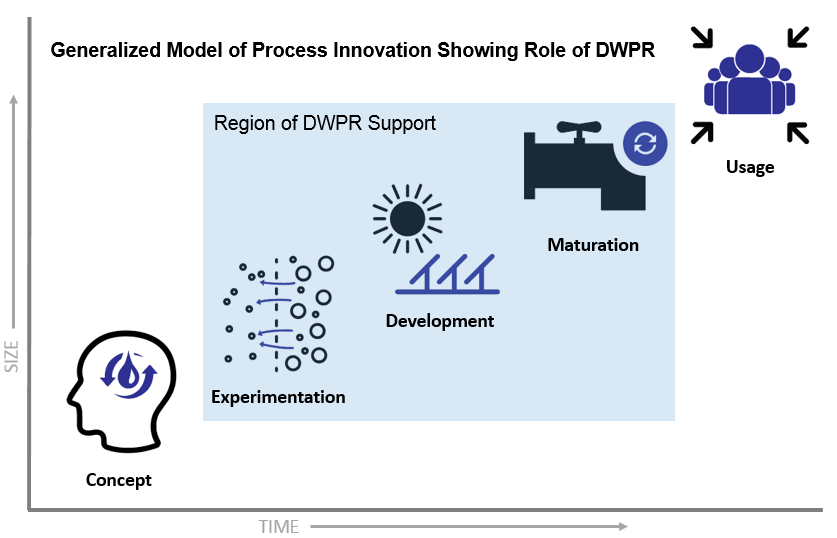- Reclamation
- R&D
- DWPR
- About
About DWPR
Water treatment is a broad field, involving a number of technical disciplines. While the need for water for irrigated agriculture is greatest west of the 100th meridian, the need for high quality water for drinking and for industry is nationwide.
The five-step model (shown below) is used for development of innovations from Concept to Usage. DWPR funding plays a critical role in iterating an idea from the lab through to a real-world demonstration that can both attract industry commercialization and serve the water treatment community in its usefulness.

Goal and Objectives
The goal of DWPR is to reduce the costs and environmental impacts of treating impaired and unusable waters. The DWPR program objectives are listed below.
- Assess environmental impacts of desalination intake and concentrate management approaches
- Develop improved intake methods at coastal facilities to minimize impingement of larger organisms and entrainment of smaller ones
- Assess the quantity and distribution of brackish water resources nationwide
- Improve pretreatment for membrane desalination
- Improve membrane system performance
- Improve existing desalination approaches to reduce primary energy use
- Develop novel approaches or processes to desalinate water in a way that reduces primary energy use
- Develop cost-effective approaches for concentrate management that minimize potential environmental impacts
- Assess the potential impacts of environmental applications of reclaimed water in sensitive ecological communities
- Quantify the nonmonetized costs and benefits of potable and nonpotable water reuse compared with other water supply sources to enhance water management decision making
- Examine the public acceptability of engineered multiple barriers compared with environmental buffers for potable reuse
- Develop a better understanding of the formation of hazardous transformation products during water treatment for reuse and ways to minimize or remove them
- Develop a better understanding of pathogen removal efficiencies and the variability of performance in various unit processes and multibarrier treatment and develop ways to optimize these processes
- Identify better indicators and surrogates that can be used to monitor process performance in reuse scenarios and develop online real-time or near real-time analytical monitoring techniques for their measurement
- Analyze the need for new reuse approaches and technology in future water management
Program Authority
The authorizing legislation for this program is the Reclamation Act of 1902, June 17, 1902, Sec.1 and Sec. 2, and the Omnibus Public Land Management Act of 2009, Public Law 111-11, section 9509, Research Agreement Authority.
Facility and Equipment Resources
Reclamation’s state-of-the-art water treatment laboratory and pilot-scale facilities may be available for use on a cost reimbursable basis. These include the Technical Service Center in Denver, Colorado, the Water Quality Improvement Center in Yuma, Arizona, and the Brackish Groundwater National Desalination Research Facility (BGNDRF) in Alamogordo, New Mexico.
Eligible Applicants
Any responsible source, including individual, institutions of higher education, commercial or industrial organizations, private entities, public entities (including state and local), non-profit organizations, or Indian Tribal Governments. Those not eligible include Federal governmental and foreign entities.

